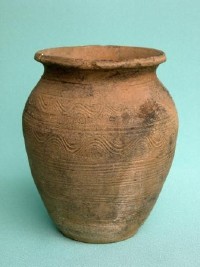Prehistoric and early history
Based on the remains of hearths and hewn stones, archaeologists have dated the first primeval man on the territory of Slovakia to approximately 200,000 BCE. However the two most precious primeval findings are substantially younger. The skull of a Neanderthal man found in Gánovce near Poprad is approximately 100,000 years old. Approximately 23,000 years ago, primeval man created a perfectly-sculpted statue of Venus which was found in Moravany, near Pieštany.
 The territory of Slovakia has been continually inhabited since the 5th millennium BCE, when the earliest settled farming communities appeared. Various ethnic groups have come and gone. We don’t know their names - that is why they are classified according to predominant archeological signs (especially ceramics).
The territory of Slovakia has been continually inhabited since the 5th millennium BCE, when the earliest settled farming communities appeared. Various ethnic groups have come and gone. We don’t know their names - that is why they are classified according to predominant archeological signs (especially ceramics).As far back as the 4th century BCE the Celts, the first known ethnic group here, founded market towns (oppidums) and minted silver coins (biatecs) on the territory of Slovakia. At the turn of the millennium, Germanic tribes – Quads and Markomen – began to push the Celts out. At the same time, the Roman Empire had spread its territory all the way up to the Danube, along which it built Limes Romanus, a continuous protective zone. And so Slovakia found itself on the border of the civilised and ‘barbarian’ worlds.
At first relations between the powerful Roman Empire and the Germans were peaceful. At the start of the first millennium the Quads, with the approval of Rome, created the first known political formation on the Slovak territory – Vanni’s Kingdom. The Romans intended to move the borderline of their empire towards the north to the ridges of Carpathians, and so to connect the territory of Slovakia directly with the empire. However this did not happen because Roman-German tensions began to grow and eventually erupted into the so-called Markoman Wars. In the course of these wars, Roman legions penetrated deeply into the Slovak interior. This is borne out by an inscription from 179 CE found in Trenčín and the fact that Marcus Aurelius, the Roman Emperor wrote his significant stoic essay Meditations on the banks of the Hron River.
